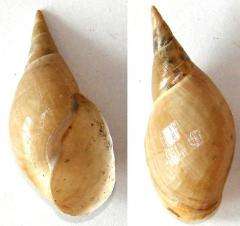November 30, 2009 weblog
Right/left handedness of snails changed in the lab

(PhysOrg.com) -- Like most animals, snails have either left- or right-handed asymmetry (chirality), both internally and externally, and the handedness is hereditary. A new study has for the first time found that handedness, as seen in the direction of a snail shell spiral, can be reversed by manual manipulation of eight cell stage embryos, which is much earlier than previously thought.
Snail shell spirals are often used as examples of chirality. The direction of the spiral is important because the sexual organs are twisted, which makes it difficult for snails to mate unless their handedness matches.
Chirality is inherited from the mother and is therefore predictable. The study found snails that were genetically programmed to have right-handed spirals could be induced to have left spirals, and vice-versa.
The research team, led by Dr Reiko Kuroda of the University of Tokyo, used tiny glass rods to physically invert the direction of four of the eight cells in over 100 embryos of the giant pond snail Lymnaea Stagnalis. When the snails matured to adulthood, around 78% had the opposite handedness, and the shell spiraled in the opposite direction to that expected. The snails were otherwise normal, fertile and healthy.
The nodal signaling pathway was also affected, with the expression patterns of the nodal gene that control it being reversed. The nodal signaling pathway is the system that determines handedness and laterality in embryos in many species. The specific gene that determines chirality has not yet been identified.
The study found the altered handedness was not inherited by subsequent generations of snails, which shows the genetic programming passed on to offspring takes precedence over the effects of the manual manipulations.
Dr Kuroda said the same effects were not found in two or four cell stages. She said that pinpointing the stage of onset of handedness at the eight cell stage may help in studies of chirality in more complex organisms.
Stuart Newman of the New York Medical College said the discovery that changes to cells at an early stage can make large changes to the body may have implications in evolutionary studies, since evolution can proceed in large jumps as well as in tiny increments.
The report was published in the online edition of Nature on 25 November.
More information: Chiral blastomere arrangement dictates zygotic left-right asymmetry pathway in snails,
Nature advance online publication 25 November 2009, doi:10.1038/nature08597
© 2009 PhysOrg.com



















